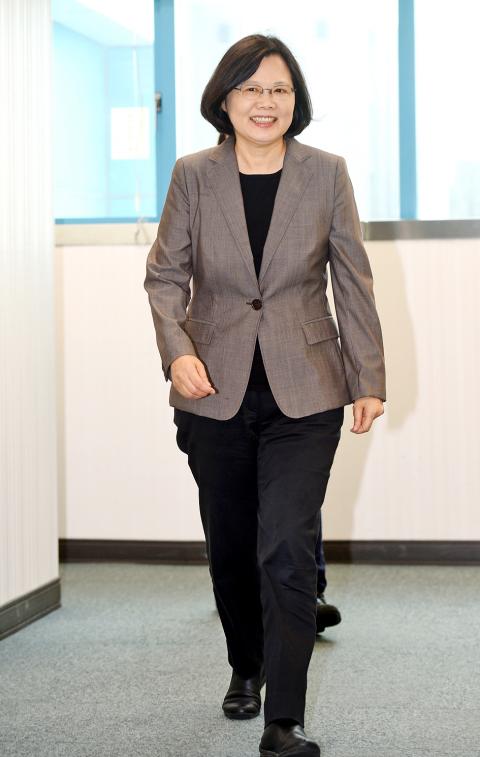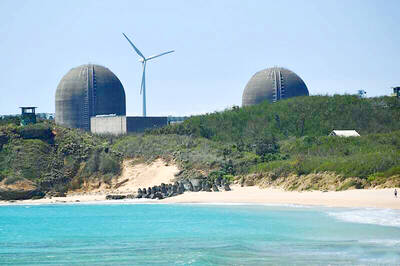The other day, I was enjoying a quiet repast at a Taipei watering hole that my cousin Johnny Neihu (強尼內湖) introduced me to, when in walked my good friend and world traveller, Gully. Gully had just returned from Washington and was bursting with news that Tsai Ing-wen (蔡英文), chairperson of the Democratic Progressive Party (DPP) and its presidential candidate, will deliver a speech in Washington on Wednesday. That raised a few eyebrows.
Wait a minute, I said, didn’t former American Institute in Taiwan (AIT) managing director Barbara Schrage lay into Tsai there a few months back, when Schrage pooh-poohed Tsai’s cross-strait policy as “disappointing?”
Piece of cake, Gully said. Schrage was simply saying that Tsai needs to get her act together if she wants to pass the DC test. Tsai disappointed the bigwigs last time she was there in September 2011 — as then DPP candidate for the 2012 presidential election — because they felt she didn’t spell out how she’d solve Taiwan’s myriad issues with that shifting 2,000-pound gorilla on the other side of the Taiwan strait. They don’t like vague namby-pamby beating around the bush in Washington. They want clear-cut, detailed answers.

Photo: lo pei-der, Taipei Times
Fair enough, I said, but hasn’t the US position on Taiwan been “undecided” for the past 70 years? That seems a bit like beating around the bush.
Now Gully’s a Brit, but he does stand up for the US on occasion. So he explained: That’s a different vagueness; the US is keeping its options open. Tsai should be more like the Chinese Nationalist Party (KMT), which invented the fake “1992 consensus,” a formula based on some bogus notion of “one China.”
Feeling I was catching on, I asked if the US likes fake? Is that why it historically backed the KMT?
Now you are getting it, said Gully. The US has no problem with fake; fake is different from beating around the bush. The KMT faked its love of democracy for years during martial law. That fake helped the US when it was against China. But now the US wants to cooperate with China.
Not wanting to let Gully off too easily, I said that China had never really agreed to the fake “1992 consensus” in the past. Their leaders only changed their mind when the fake consensus could be interpreted favorably with their fake idea of one fake China.
True, Gully answered, but some in the US fear that Taiwan’s actions might get the US involved in a war; wars are destructive. Understand?
No problem, but then how do you explain the Persian Gulf war, the war in Afghanistan and the fake weapons of mass destruction (WMD) that led in part to the Iraq war? Those latter two wars have been destructive quagmires and had nothing to do with Taiwan.
Gully was not to be distracted. Those are different, he said. There are wars and then there are wars. The Gulf war was more a matter of oil and the WMD — that was a fake of a different kind.
Not sure I was following Gully’s logic, I went back to Tsai’s reception. OK, but today’s not the 18th century when people invented fake maps like that chap George Psalmanazar. Schrage was an AIT bigwig, and the institute has had real directors here for more than three decades. So shouldn’t the US with its lingering uncertainty understand the dilemmas faced by Taiwan’s democracy?
Gully admitted that, of course, Taiwan is a democracy. But its people have not been following the US’s script. That’s not very democratic of them, he said. Sensing a breakthrough I blurted, so you mean that the DPP should say that it is “uncertain” about the cross-strait relations?
No, no, no, Gully said. That would go back to beating around the bush. What Tsai needs is a new fake.
A new fake? That might have a little logic, I granted. But then if the AIT has been in Taiwan for so long with all this fakery, why did the student-led Sunflower movement and the DPP’s electoral victory in the nine-in-one elections last year catch both the KMT and the US by surprise?
Gully sighed and patiently explained that, yes, the AIT has been in Taiwan for a long time, but its people generally have only listened to the KMT’s fake and not the people of Taiwan.
You mean, I tentatively asked, the KMT’s half-century fake pursuit of democracy and the fake “1992 consensus?” I always did wonder why Germany and Japan got democracy quicker than Taiwan after World War II. But back to Schrage. So she represents AIT and the US?
Wrong again, Gully corrected me; she is retired and only a private citizen now.
So why all this posturing then? That’s a different fake, Gully said. Sometimes the US uses a fake speaker to get across the real message on how the DPP needs a better fake to resolve the problems that China creates with its fake claims.
I thought I had it and said, alright, so Tsai has to learn a new fake, one that is pleasing to both China and the US even though they both have different ideas of what that fake might be. And then she must also fake support of the fake “status quo” even though others are constantly changing it?
I think that sums it up, said Gully. Now as for the KMT’s drubbing in the last election, that sometimes happens when too much fake collides with reality. So, have you learned anything?
Uh, yes, I said somewhat hesitantly. The last person I should ask about Taiwan is a retired AIT director who lives in Washington. Forget it, cried an exasperated Gully, I’m buying.
Chopped Suey, a satirical column published on the first Monday of every month, will comment on issues related to the forthcoming presidential and legislative elections to be held on Jan. 16, 2016.

July 28 to Aug. 3 Former president Chiang Kai-shek (蔣介石) reportedly maintained a simple diet and preferred to drink warm water — but one indulgence he enjoyed was a banned drink: Coca-Cola. Although a Coca-Cola plant was built in Taiwan in 1957, It was only allowed to sell to the US military and other American agencies. However, Chiang’s aides recall procuring the soft drink at US military exchange stores, and there’s also records of the Presidential Office ordering in bulk from Hong Kong. By the 1960s, it wasn’t difficult for those with means or connections to obtain Coca-Cola from the

Taiwan is today going to participate in a world-first experiment in democracy. Twenty-four Chinese Nationalist Party (KMT) lawmakers will face a recall vote, with the results determining if they keep their jobs. Some recalls look safe for the incumbents, other lawmakers appear heading for a fall and many could go either way. Predictions on the outcome vary widely, which is unsurprising — this is the first time worldwide a mass recall has ever been attempted at the national level. Even meteorologists are unclear what will happen. As this paper reported, the interactions between tropical storms Francisco and Com-May could lead to

A couple of weeks ago the parties aligned with the People’s Republic of China (PRC), the Chinese Nationalist Party (KMT) and the Taiwan People’s Party (TPP), voted in the legislature to eliminate the subsidy that enables Taiwan Power Co (Taipower) to keep up with its burgeoning debt, and instead pay for universal cash handouts worth NT$10,000. The subsidy would have been NT$100 billion, while the cash handout had a budget of NT$235 billion. The bill mandates that the cash payments must be completed by Oct. 31 of this year. The changes were part of the overall NT$545 billion budget approved

No one saw it coming. Everyone — including the Chinese Nationalist Party (KMT) — expected at least some of the recall campaigns against 24 of its lawmakers and Hsinchu Mayor Ann Kao (高虹安) to succeed. Underground gamblers reportedly expected between five and eight lawmakers to lose their jobs. All of this analysis made sense, but contained a fatal flaw. The record of the recall campaigns, the collapse of the KMT-led recalls, and polling data all pointed to enthusiastic high turnout in support of the recall campaigns, and that those against the recalls were unenthusiastic and far less likely to vote. That